Abstract
High levels of heavy metals in the vegetables are seriously influencing the ecosystem as well as causing many health glitches. Due to many factors like, discharge of untreated industrial effluent, mine tailing, fertilizer application and irrigation with different water sources, the levels of heavy metals increased in soils which further transferred in biological systems. The present study was designed to access bioconcentration of Cr, Mn, Fe, Co, Ni, Cu, Zn, As, Se, Mo, Cd, and Pb in soils and vegetables (carrots) irrigated with wastewater in Punjab, Pakistan. Result of the study showed that at both study sites concentrations of As and Cd were above the permissible maximum limits (PML). Similarly, concentrations of Mn, Ni, Mo, Cd, and Pb in the vegetable samples of both study sites were higher than maximum permissible limits. Overall, the accumulation of metals (Mn, Ni, Mo, Cd, and Pb) observed in carrots as well as in the soil was beyond the permissible limit that may cause human health disorders for their consumers.
Similar content being viewed by others
References
Alam MGM, Snow ET, Tanaka A (2003) Arsenic and heavy metal contamination of vegetables grown in Samta village, Bangladesh. Sci Total Environ 308:83–96
Angula E (1996) The Tomlinson pollution index applied to heavy metal, Mussel-Watch data: a useful index to assess coastal pollution. Sci Total Environ 187:19–56
Bahemuka TE, Mubofu EB (1999) Heavy metals in edible green vegetables grown along the sites of the Sinza and Msimbazi rivers in Dar es Salaam, Tanzania. Food Chem 66:63–66
Chojnacka K, Chojnacki A, Gorecka H et al (2005) Bioavailability of heavy metals from polluted soils to plants. Sci Total Environ 337:175–182
Cui YJ, Zhu YG, Zhai RH (2004) Transfer of metals from near a smelter in Nanning, China. Environ Int 30:785–791
Gupta N, Khan DK, Santra SC (2008) An assessment of heavy metal contamination in vegetables grown in wastewater-irrigated areas of Titagarh, West Bengal, India. Bull Environ Contam Toxicol 80:115–118
Hassan I, Bakhsh K, Salik MH et al (2005) Determination of factors contributing towards the yield of carrot in Faisalabad (Pakistan). Int J Agric Biol 7:323–324
Helgesen H, Larsen EH (1998) Bioavailability and speciation of arsenic in carrots grown in contaminated soil. Analyst 123:791–796
Hinojosa MB, Carreira JA, Garcia-ruiz R (2004) Soil moisture pre treatment effects on enzyme activities as indicators of heavy metal-contaminated and reclaimed soils. Soil Biol Biochem 36:1559–1568
Kawada T, Lee Y, Suzuki S et al (2002) Copper in carrots by soil type and area in Japan: a baseline study. J Trace Element Med Biol 16:179–182
Khan S, Cao Q, Zheng YM, Huang Y et al (2008) Health risks of heavy metals in contaminated soils and food crops irrigated with wastewater in Beijing, China. Environ Pollut 152:686–692
Koenig W, Leistner J, Prange C (1990) Soil examination in vegetable gardens on hazardous waste sites. Umwelt 20:105–106
Latif MI, Lone MI, Khan KS (2008) Heavy metal contamination of different water sources, soils and vegetables in Rawalpindi area. Soil Environ 27:29–35
Liu WH, Zhao JZ, Ouyang ZY et al (2005) Impacts of sewage irrigation on heavy metals distribution and contamination. Environ Int 31:805–812
Okonkwo NC, Igwe JC, Onwuchekwa EC (2005) Risk and health implications of polluted soils for crop production. Afr J Biotechnol 4:1521–1524
Radwan MA, Salama AK (2006) Market basket survey for some heavy metals in Egyptian fruits and vegetables. Food Chem Toxicol 44:1273–1278
Rashidi M, Bahri MH (2009) Interactive effects of relative humidity, coating method and storage period on quality of carrot (cv. Nantes) during cold storage. ARPN J Agric Biol Sci 4:26–34
Sinha S, Gupta AK, Bhatt K et al (2006) Distribution of metals in the edible plants grown at Jajmau, Kanpur (India) receiving treated tannery wastewater, relation with physicochemical properties of the soil. Environ Monitor Assess 115:1–22
Steel RGD, Torrie JH (1980) Principles and procedures of statistics, a biometrical approach, 2nd edn. McGraw Hill Book Co. Inc., New York, pp 336–354
Steenland K, Boffetta P (2000) Lead and cancer in humans: where are we now? Amer J Ind Med 38:295–299
Szabo G, Czeller K (2009) Examination of the heavy metal uptake of carrot (Daucus carota) in different soil types. AGD Lands Environ 3:56–70
USEPA (US Environmental Protection Agency) (1997) Exposure factors handbook. Volume II—food ingestion factors. EPA/600//P-95/002Fa. Office of Research and Development. Washington, DC, USA
WHO (1996) Trace elements in human nutrition and health. World Health Organization, Geneva
Yadav A, Yadav K, Shukla DN (2013) Investigation of heavy metal status in soil and vegetables grown in urban area of Allahabad, Uttar Pradesh, India. Int J Sci Res Public 3:1–8
Zheng N, Wang Q, Zhang X et al (2007) Population health risk due to dietary intake of heavy metals in the industrial area of Huludao City, China. Sci Total Environ 387:96–104
Author information
Authors and Affiliations
Corresponding author
Rights and permissions
About this article
Cite this article
Ahmad, K., Khan, Z.I., Yasmin, S. et al. Contamination of soil and carrots irrigated with different sources of water in Punjab, Pakistan. Environ Earth Sci 75, 426 (2016). https://doi.org/10.1007/s12665-016-5348-4
Received:
Accepted:
Published:
DOI: https://doi.org/10.1007/s12665-016-5348-4




